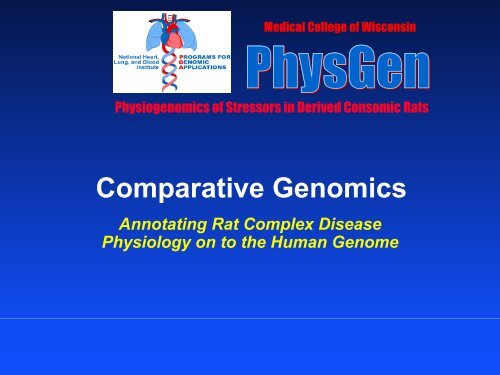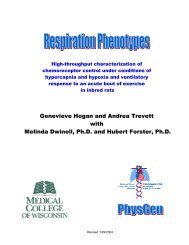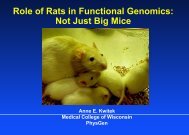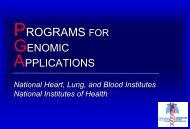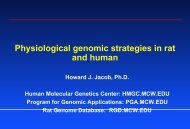Comparative Genomics - Medical College of Wisconsin
Comparative Genomics - Medical College of Wisconsin
Comparative Genomics - Medical College of Wisconsin
You also want an ePaper? Increase the reach of your titles
YUMPU automatically turns print PDFs into web optimized ePapers that Google loves.
<strong>Medical</strong> <strong>College</strong> <strong>of</strong> <strong>Wisconsin</strong><br />
Physiogenomics <strong>of</strong> Stressors in Derived Consomic Rats<br />
<strong>Comparative</strong> <strong>Genomics</strong><br />
Annotating Rat Complex Disease<br />
Physiology on to the Human Genome
Physiological <strong>Genomics</strong><br />
• The rat has centuries <strong>of</strong> physiological data<br />
• The technology <strong>of</strong> the last two decades<br />
has resulted in vast genomic data<br />
• The merging <strong>of</strong> the two is critical to<br />
developing better models for<br />
understanding complex human disease
What makes a good disease model<br />
1. Characteristics <strong>of</strong> the clinical picture<br />
No model can match the complete clinical picture,<br />
as no single patient reflects the entire clinical<br />
spectrum.<br />
2. Inbred (homozygous through-out the genome)<br />
Reduced heterogeneity: genetics and etiology<br />
3. Physiologically and pathologically well characterized.<br />
4. “Natural” disease alleles.
Goal for Animal Models<br />
Phenotype<br />
Genotype
<strong>Comparative</strong> <strong>Genomics</strong> Approach<br />
• Choose model system that reflects<br />
aspects <strong>of</strong> clinical picture<br />
• Good systems biology<br />
• Mapping <strong>of</strong> trait to the model organism<br />
genome<br />
• Identify syntenic region in human<br />
• Follow up candidate gene/region in<br />
populations<br />
• Follow up disease mechanism in model
LOD<br />
Map<br />
Animal model<br />
Linkage analysis<br />
Controlled genetic background<br />
Controlled environment<br />
Controlled experimental setting<br />
Identification <strong>of</strong> homologous region<br />
CA<br />
Animal<br />
Human<br />
CA<br />
Association analysis in human
Animal Models
Human vs. Animal Model Hypertension<br />
Human<br />
SHR<br />
Dahl-S<br />
SHRSP<br />
GH<br />
FHH<br />
LH
TPR<br />
X<br />
cardiac output<br />
Arterial Pressure<br />
(MAP, SBP, DBP, HR)<br />
blood volume<br />
( •body wt.; HCT)<br />
sodium balance<br />
Vessels<br />
(structure & function)<br />
Likely determinant phenotype:<br />
•blood lipids<br />
(TG/LDL/HDL)<br />
• ∆MAP/vasc. reactivity<br />
(AII, NE, Ach, L-NAME)<br />
•microvessel density<br />
•aorta & heart weight<br />
Kidney<br />
(structure & function)<br />
Likely determinant phenotype:<br />
•pressure-natriuresis<br />
(∆MAP/∆salt; 24h UNaV)<br />
•GFR (C creat<br />
); U prot<br />
•renal blood flow<br />
• ∆ RVR (vasc. reactivity)<br />
•kidney weight & histology<br />
Neuroendocrine<br />
(sympathetic/hormones/<br />
paracrines)<br />
Likely determinant phenotype:<br />
•renin activity<br />
•vasopressin<br />
• ∆ MAP/HR with startle<br />
• ∆ HR/∆ salt
Cross<br />
SS<br />
BN Control<br />
F1<br />
Intercross
Blood Pressure Phenotype QTL
Cluster Analysis <strong>of</strong> overlapping QTLs
Consomic for BN<br />
SS/MCW<br />
BN<br />
SS/MCW<br />
Chr. 3<br />
BN<br />
SS/MCW<br />
BN<br />
SS/MCW<br />
Chr. 1<br />
BN<br />
SS/MCW<br />
Chr. 4<br />
BN<br />
SS/MCW<br />
Chr. 2<br />
Chr. 5
Using Consomics to Generate Congenics<br />
BN<br />
SS/MCW<br />
SS/MCW<br />
x<br />
Chr. 1 Chr. 1<br />
F1<br />
F2
Genome Structure <strong>of</strong> Congenic Strain<br />
1 2 3 4 5 6 7 8 9 10 11 12 13 14 15 16 17 18 19 20 X<br />
A genome:<br />
B genome:
Applications <strong>of</strong> Congenic Strains<br />
• Tool for Physiological <strong>Genomics</strong>:<br />
– Simple comparison: 2X2 study design<br />
– Investigate gene-gene interaction: designer congenics<br />
– Lead compound screening<br />
• Tool for Positional Cloning:<br />
– Reduce trait to a single gene model<br />
– Interval reduction to narrow the genomic region <strong>of</strong><br />
interest
Phenotype<br />
Genotype
Evolutionary Conservation <strong>of</strong> Genomes<br />
• Many genes have been conserved with respect to<br />
function and sequence across evolution<br />
• Genome organization also tends to be conserved<br />
across relatively close species, i.e. large<br />
segments <strong>of</strong> chromosomes have remained intact<br />
in closely related species<br />
• Genome organization and gene order is relatively<br />
well conserved in mammalian species<br />
• Mapped, orthologous genes allow for the<br />
identification <strong>of</strong> conserved segments and the<br />
generation <strong>of</strong> comparative maps
Requirements<br />
<strong>Comparative</strong> <strong>Genomics</strong> (and Model<br />
Organism research in general) requires the<br />
ability to translate information obtained in<br />
one organism to application in another<br />
organism(s). This achieved by having<br />
common frames <strong>of</strong> reference (connections)<br />
between these organisms.
<strong>Comparative</strong> Mapping<br />
• Chromosome Painting<br />
• Cytogenetic Mapping<br />
• Genetic Mapping<br />
• RH Mapping<br />
• Sequence Comparisons<br />
Low Resolution<br />
High Resolution
Chromosome Painting<br />
Grützner, et al., 1999
<strong>Comparative</strong> Mapping by FISH<br />
Grützner, et al., 1999
Genetic Map - Backbone
Radiation Hybrid Mapping<br />
• Map markers based upon presence/absence in<br />
radiation hybrid cell line<br />
• Map non-polymorphic markers<br />
• Map integration within and between species<br />
• Map potential candidate genes
<strong>Comparative</strong><br />
Map <strong>of</strong> RNO19<br />
with RH<br />
backbone<br />
VCMAPs
Expanded <strong>Comparative</strong><br />
Map Information
http://rgd.mcw.edu/VCMAP/
RAT GENOME SEQUENCING PROJECT<br />
Baylor <strong>College</strong> <strong>of</strong> Medicine<br />
NHGRI/NHLBI<br />
Richard Gibbs<br />
UBC<br />
Rob Holt<br />
Celera<br />
Shaying Zhao<br />
TIGR<br />
Pieter de Jong<br />
CHO<br />
Robert Weiss<br />
Univ Utah
Sequence Analysis Through SAAAP<br />
D1Rat118<br />
D1Rat86<br />
1 QTL Region<br />
~20 Mbp<br />
Initial<br />
55 BACs<br />
GenBank<br />
Trace DB<br />
HTGS<br />
DB EST<br />
Assembled<br />
Contigs
Rat<br />
A Representative Homologue Annotation
VCMap Report <strong>of</strong> Marker D10S1753
Human-Rat<br />
<strong>Comparative</strong><br />
Sequence<br />
Analysis
38,39,40,41<br />
11,15,16,17,19<br />
21,23-25<br />
29,30,31,32,37<br />
33,34,35,36<br />
28<br />
44,45,46<br />
49,50,51,52<br />
11,15,16,17,19<br />
21,23-25<br />
49, 50,51,52<br />
26,27<br />
Krushkal et al.<br />
12,13,14,18<br />
20,22,25<br />
12,13,14,18<br />
20,22,25<br />
Mansfield et al.<br />
Chr.1 Chr.2 Chr.3 Chr.4
SNP identification using sequencing technology
LOD<br />
QTL mapping<br />
Map<br />
1 2 3 4 5 6 7 8 9 10 11 12 13 14 15 16 17 18 19 20 X<br />
Congenic<br />
SS<br />
Expression pr<strong>of</strong>iling<br />
Screen BACs:<br />
Sequencing<br />
Physiological<br />
Experiments<br />
Test as disease marker<br />
Refined phenotyping: Clinic
General Microarray Methodology<br />
mRNA from<br />
‘Control’ tissue<br />
mRNA from<br />
‘Diseased’ tissue<br />
Single-stranded cDNA<br />
labeled with two fluorescent<br />
dyes (RT) (Cy3/Cy5)<br />
Slide stamped<br />
with cDNA clones<br />
Add equal amounts <strong>of</strong><br />
fluorescently labeled<br />
cDNAs to microarray<br />
Expression<br />
Level<br />
Scan and<br />
Quantitate
Microarray Data: Rat Kidney Congenic (Cy3) vs. ACI (Cy5)<br />
9216 cDNA
Microarray <strong>of</strong> FHH vs. ACI using Reciprocal Cy3/Cy5 Labelin<br />
ACI = Cy3 (red)<br />
FHH = Cy5 (green)
Rat<br />
<strong>Comparative</strong><br />
Map<br />
Human<br />
Genetic Map RH Map<br />
RH Map<br />
Genetic Map<br />
Microarray<br />
Data<br />
QTLs<br />
QTLs
PGA Members<br />
• <strong>Genomics</strong> - Howard Jacob, Ph.D.<br />
– Pierre Dumas, Ph.D.<br />
– Kathleen Kennedy, Jo Handley, Mike<br />
Tschannen<br />
– Sheri Jene, Janet Gell-R<strong>of</strong>kahr, Nadia<br />
Barreto<br />
• Bioinformatics - Peter Tonellato, Ph.D.<br />
– Zhitao Wang<br />
– Michael Thomas, Ph.D.<br />
– Zhanchi Wang<br />
– Qunli Cheng<br />
• Research Services - Andrew Greene, Ph.D.<br />
– Greg McQuestion, Michael Kloehn<br />
– David Eick, Bonnie Pfau-Wentworth<br />
– Kevin Wollenzien, Glenn Slocum<br />
• Education - Anne Kwitek-Black, Ph.D.<br />
– Rebecca Bosque<br />
• PGA coordinator - Julie Messinger, M.S.<br />
• Administration - Jane Brennan-Nelson<br />
– Diane Kelley<br />
• Phenotyping - Allen Cowley, Jr. Ph.D.<br />
• Mary Pat Kunert, RN, Ph.D.<br />
• Mindy Dwinell, Ph.D.<br />
– John Baker, M.D.<br />
– Michael Bregantini, Lawrence<br />
Clowry<br />
– Bernadette Cabigas, Jess Powlas<br />
– Jenny Hogan, Andrea Trevett<br />
– Jennifer Labecki<br />
– Christopher Dawson, Ph.D.<br />
– Hubert Forster, Ph.D.<br />
– William Hutchins, Jessica Laessig<br />
– Candace Jones<br />
– Julian Lombard, Ph.D.<br />
– David Mattson, Ph.D.<br />
– Kirkwood Pritchard, Ph.D.<br />
– Richard Roman, Ph.D.-Quality<br />
Control<br />
– Meredith Skelton, M.S.<br />
– Janelle Yarina, Alison Kriegel
Acknowledgments<br />
Director <strong>of</strong> BRC<br />
•Peter Tonellato<br />
Assistant Pr<strong>of</strong>essors<br />
•Simon Twigger<br />
Collaborators<br />
Janan Eppig and MGD team<br />
Greg Schuler and NCBI team<br />
Val Sheffield and UI team<br />
Students<br />
•Roumyana Kirova<br />
Pr<strong>of</strong>essional Staff<br />
•Dan Chen<br />
•Jian Liu<br />
•Nathan Pedretti<br />
•Mary Shimoyama<br />
•Zhitao Wang<br />
•Hai Ping Xia
The Jacob Lab Team<br />
• Nadia Barreto<br />
• Gretta Borchardt<br />
• Rebecca Bosque<br />
• Ulrich Broeckel<br />
• Danilo Carlos<br />
• Kendall Choate<br />
• Patricia Corat<br />
• Pierre Dumas<br />
• Jeffrey Eckert<br />
• Thomas Feroah<br />
• Jo Gullings-Handley<br />
• Jennifer Holland<br />
• Howard Jacob<br />
• Sheri Jene<br />
• Michael Jensen-Seaman<br />
• Joseph Johnnie<br />
• Kathleen Kennedy<br />
• Shehnaz Khan<br />
• Beth Konicek<br />
• Rachel Kraemer<br />
• Michelle Feldmann• Anne Kwitek<br />
• Lorie Figie • Angela Lemke<br />
• Jacob Frautschi • Diane Linzmeier<br />
• Li Gao<br />
• Michelle Lombard<br />
• Diana Maas<br />
• Rebecca Majewski<br />
• Nasuh Malas<br />
• Dan Maloney<br />
• Karen Maresso<br />
• Andrea Matter<br />
• Julia Messinger<br />
• Kimberly Orlebeke<br />
• Lisa Philips<br />
• Nancy Schlick<br />
• Jennifer Tackes<br />
• Michael Tschannen<br />
• Jaime Wendt Andrae<br />
• Carrie Wheeldon


